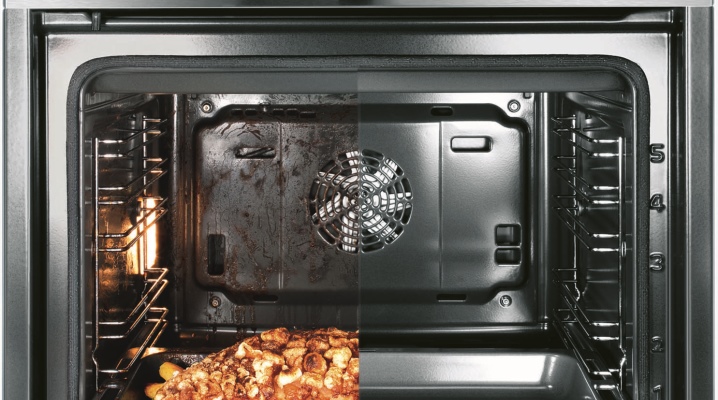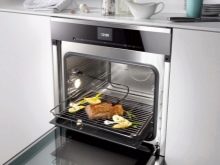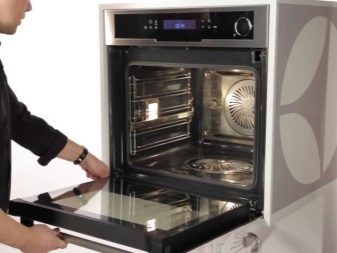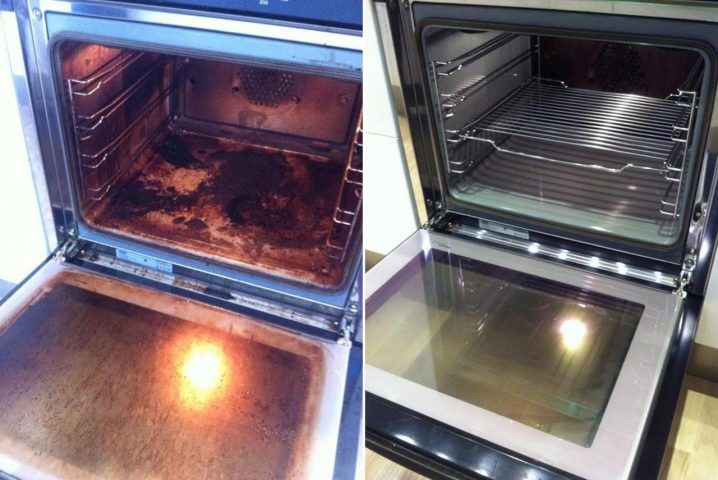Catalytic oven cleaning: what is it and how does it work?

Until recently, the main problems of ovens were fumes and fat deposits, which settled on the inner walls of the appliance and accumulated over time. These contaminants did not respond well to traditional cleaning, requiring the regular use of abrasives and metal sponges. However, at the moment, the problem has been successfully resolved thanks to a special catalytic purification technology.



Method essence
The catalytic cleaning of the oven is self-occurring reaction of splitting fat, soot and other substancesgenerated during cooking. The process of decomposition of complex compounds into carbon and water has become possible thanks to special plates that cover the inner surface of the oven. The secret of these plates lies in a special enamel coating, which includes oxidizing chemical catalysts, absorbents consisting of nanoparticles, as well as porous and non-porous substrates.


The principle of operation of the miracle coating is based on the rules of chemical reactions in a hot environment.... It consists in the following: during cooking, when the temperature in the oven exceeds 200 degrees, the process of breaking down fat begins. Its course is characterized by the simultaneous removal of decomposition products, which becomes possible due to the action of nanoparticles.
The reaction proceeds due to the activation of a chemical catalyst, which begins to work automatically, as soon as the temperature overcomes the above threshold. It should be noted here that the more the temperature in the oven rises, the more actively the digestion process proceeds. Its acceleration occurs with the help of copper oxide, cobalt and manganese, which play the role of the main catalysts.
Grease-absorbing enamel is applied to all walls of the oven with the exception of the bottom and glass door... This is due to the fact that during the baking process, jam, jam, melted sugar, and dairy components often flow down to the bottom of the appliance. Burning instantly on a hot surface, these products can damage the enamel coating, so the bottom of the oven is made of traditional materials.
In some built-in electric ovens, the enamel coating is additionally applied to the fan blades, allowing them, like the inner walls of the appliance, to always remain clean.

Advantages and disadvantages
Like any other modern technology, catalytic oven cleaning has both strengths and weaknesses. To the benefits methods include a number of important points.
- Full automation of the process cleaning does not involve human participation, which greatly simplifies the care of the oven.
- Low temperature threshold starting the cleaning process, often only 150 degrees, allows you to get rid of fatty contaminants even when using the oven at low temperatures.
- Unlike pyrolytic cleansingwhich is carried out after cooking, requires high temperatures and high energy consumption, catalytic cleaning is carried out during cooking and does not require additional waste of time and electricity. In addition, this method is much more effective than steam cleaning: it not only breaks down grease and other contaminants, but also removes them from the inner surface of the oven.
- This method is universal, it can be used not only in electric but also in gas ovens.
- Catalytic cleaning function practically does not affect the cost of the oven.
- Items adjacent to the oven furniture do not experience high temperature loads during cleaning, unlike, for example, pyrolysis models, for which the device is heated up to 500 degrees for cleaning.



By cons the catalytic procedure refers to a lower, in comparison with pyrolysis, purification efficiency... This is due to the fact that only the walls of the appliance are coated, so the grate, metal sheets, grill and door have to be cleaned manually.
In addition, when sticky and sweet substances get on the enamel coating, the cleansing process in these areas stops.
It is worth noting that special enamel loses its working qualities over time, which is why the plates have to be changed every 5 years. To extend the service life, it is recommended to wipe the enamel only with a soft cloth; the use of rough and coarse fabrics is prohibited. However, for the sake of fairness, it should be noted that removable panels of this type are often double-sided. Therefore, with the loss of working properties of one of the sides, the sheet is safely turned over and used for another 5 years.
Among the minuses, they also note incomplete breakdown of fat when the oven is switched on for a short time... However, its final removal necessarily occurs when the device is reused. Therefore, this type of cleaning is more suitable for those who use the oven regularly.
For those who rarely bake, it is better to choose simple models, which after each use it is enough to clean it with a hard sponge and leave it clean until the next time.


Popular models with cleaning function
Among the electrical built-in cabinets equipped with the option of catalytic cleaning of the inner surface, a number of models should be highlighted.
- Oven Bosch HBN 431E3 made of stainless steel and painted black. The volume of the oven is 67 liters, the maximum heating temperature is 250 degrees. The model is equipped with a grill, thermostat, timer, child protection and is capable of working in seven modes. The device is produced in dimensions 60x60x65 cm, has a power of 2.8 kW and costs 12,728 rubles.
- Electric oven Samsung NV70K1341BG also equipped with a catalytic cleaning function, has a volume of 70 liters and is capable of heating up to a temperature of 250 degrees. The dimensions of the embedding are 57.2x56x54.5 cm, the power of the electric grill is 1.6 kW, the price is 17 684 rubles.
- Oven with catalytic cleaning Korting OKB 470 CMX with a capacity of 66 liters, it can work in seven modes, is equipped with defrosting and convection functions, has an electric grill and a timer with the ability to turn off the oven. The model is produced in dimensions 59.7x59.6x54.7 cm and costs 24 490 rubles.



Summing up, it should be noted that the method of catalytic cleaning of ovens is ideal for those who often use the appliance, but do not want to overpay for an overly advanced model. The chemical method is the most accessible, does not require human intervention and is able to minimize the maintenance of the oven.


For information on how catalytic cleaning of the oven works, see the following video.













The comment was sent successfully.